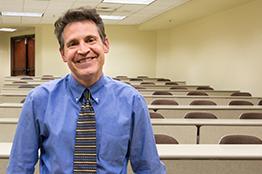John McCarthy, Ph.D.
- Dean, College of Health Sciences and Professions
- Professor of Communication Sciences and Disorders
Areas of Expertise
- AAC Systems Design
- AAC in Children
- Augmentative and Alternative Communication (AAC)
- Children With Severe Disabilities
- Communication Disorders
- Interprofessional Communication
- Interprofessional Education
Expert Bio
麦卡锡对帮助那些能听但不能说话的人的兴趣促使他在辅助和替代交流(AAC)领域进行了创新研究,这一领域的重点是帮助那些语言严重受损,无法满足日常交流需求的人。
麦卡锡说,当他谈到他的工作时,通常会想到手语的使用,但AAC更广泛地专注于创造技术,帮助那些能听到声音但有语言障碍的人找到一种有效地与他人交流的方法。
Augmentative (supplement) and alternative (replacement) communication help individuals exchange information and express needs, wants, social closeness and social etiquette. AAC can be used by children and adults for several types of impairments:
- Developmental diseases like cerebral palsy and autism.
- Acquired conditions such as a traumatic brain or spinal cord injury.
- Degenerative diseases like muscular dystrophy or amyotrophic lateral sclerosis.
- Temporarily inability to speak after surgery or intubation.
McCarthy’s research focuses on children with speech and/or language impairments related to the above conditions. Through his work, he has helped develop and design computer interfaces and technology to enhance children’s ability to communicate and learn.
Initially earning a bachelor of music degree in voice performance as an undergraduate, McCarthy originally thought he would work with singers who have voice disorders. Then he discovered a population with little or no access to their voice. Through his music background, he collaborated with music therapists to research how musical experiences can expand creative possibilities for children and young adults.
McCarthy emphasizes the importance of working with these children, their parents, and other adults who work closely with them in order to get an idea of the children’s perspectives, preferences, and views on the world.
AAC devices are often designed by adults without children’s consideration, which can lead to frustration when children try to use them to communicate, McCarthy says. On these devices designed for adults, words are presented in rows and columns of boxes, and literate adults who are used to writing in sentences can separately choose each word to easily create speech.
However, children do not think of their world in boxes, and the same goes for isolated words. McCarthy gives the example of a child wanting a pillow, and that the child is more likely to see the pillow in the context of being in his or her bedroom along with a bed and blanket.
“I design interfaces that capitalize on the idea of language in context for children,” he says. “I use drawings or photographs of actual spaces where a child just needs to touch the item in the drawing or photograph, instead of trying to find an isolated word in a box.”
McCarthy is also trying to find ways for children who are affected by a physical disability and cannot touch the screen to utilize these devices using motions.
Devices that allow the user’s body language and gestures to create speech are b.ecoming more accessible and affordable, McCarthy said. Several apps have been created for iPad, iPhone, and Android-based devices. This has led specialized design companies to transition to mobile platforms. Research and development is still in progress in the area of mobile platforms, but researchers are hopeful due to their many capabilities in regard to GPS, Internet access, and accelerometers, or the feature that detects which way a person is holding the device, he says.
McCarthy is excited by the abundance of technology now available to increase education and awareness about AAC. He recently completed work on an interactive casebook that provides teaching material about AAC in the form of video and audio clips, examples of reports, testimonials from parents and guidance from expert clinicians across the country. The casebook, available on DVD or web stream, allows for interactive teaching and learning no matter where students are located.
